.jpg)
2000 Porsche 911 Turbo
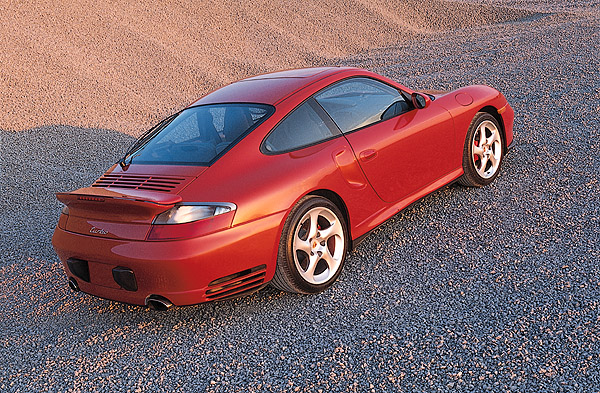
ATLANTA – Porsche has introduced the all-new 2001 911™ Turbo as its top-of-the-line model. With a 415-horsepower twin-turbo engine, advanced all-wheel drive and exclusive styling, the new 911 Turbo will take its place at the top of the Porsche model line and in the top echelon of the supercar category. The 911 Turbo arrived at Porsche dealerships in the United States and Canada this past summer with a manufacturer’s suggested retail price (MSRP) of $111,000 in the U.S. and $162,516 in Canada.
“Like the Porsche brand itself, the 911 Turbo has become an enduring symbol among high-performance sportscars,” said Frederick J. Schwab, president and CEO, Porsche Cars North America. “The 2001 911 Turbo is not only a technology masterpiece, but is simply the fastest, best-handling, best-equipped production car Porsche has ever offered in North America.”
A racecar-derived 3.6-liter, twin-turbo six-cylinder engine gives the 2001 911 Turbo staggering performance capability. The engine produces 415 horsepower (309 kW) @ 6,000 rpm and sustains 415 lb.-ft. (560 Nm) of peak torque from 2,700 rpm to 4,600 rpm. Power drives through a standard six-speed manual transmission. For the first time on a 911 Turbo, Porsche will offer the advanced Tiptronic S five-speed automatic transmission as an option.
With power characteristics of a far larger engine, the 911 Turbo can accelerate from 0-62 mph (0-100 km/h) in just 4.2 seconds. On the test track, the 911 Turbo will sprint from a standstill to 100 mph (160 km/h) in only 9.2 seconds and can achieve a top speed of 189 mph (305 km/h). Porsche builds the all-new 911 Turbo on the all-wheel drive 911 Carrera® 4 platform, a practice it started with the previous-generation 911 Turbo in 1996. All-wheel drive, the Porsche Stability Management system (PSM), and 18-inch wheels combine to make the 2001 911 Turbo the best-handling production car that Porsche has ever made.
The 911 Turbo stands apart from the 911 Carrera models with all-new front and rear styling, as well as a wider stance. Up front, the 911 Turbo features unique bi-xenon headlight clusters (xenon high-intensity discharge headlights for both the low and high beams). Three large intake grills dominate the lower front fascia and provide cooling air to the car’s three radiators. Together, the three radiators provide 50 percent more cooling surface than in the 911 Carrera and 911 Carrera 4 models.
At the rear, Porsche widened the 911 Turbo by 2.6 inches (65 mm) to accommodate the 18-inch alloy wheels and massive 295/30 ZR18 tires. Air scoops integrated into the leading edges of the rear fenders channel air to the intercoolers, while louvers in the sides of the lower rear cover exhaust air from the turbocharger wastegates. The engine compartment lid carries an a l l - n e w two-piece rear stabilizer wing, the upper part of which automatically raises at speeds above 75 mph (120 km/h) and lowers at 50 mph (80 km/h). Intake air enters through the wing.
Porsche has always equipped the 911 Turbo for comfortable, long-distance touring. As the top of the Porsche model line, the 911 Turbo adds several luxury features over and above the standard equipment on the 911 Carrera 4, including full-power adjustable leather seats for the driver and passenger (with driver’s side memory), a trip computer, premium sound system with 10 speakers and six-channel amplifier, and a three-spoke leather covered steering wheel with Porsche Crest ®. The 911 Turbo also comes with a standard programmable remote entry and security system with alarm and immobilizer. The driver can control the seat memory and open the luggage compartment with the remote control. In addition, customers may choose one of the metallic paint options at no extra cost. (See below for more standard equipment.)
Porsche derived the 3.6-liter, horizontally opposed six-cylinder engine in the 2001 911 Turbo from the Porsche GT1 racecar, which won the prestigious 24-Hours of Le Mans in 1998. To accommodate the high boost pre s s u re pro d u c e d by its dual turbochargers, the engine features a 9.4-to-1 compression ratio, compared to 11.3-to-1 for the 911 Carrera and 911 Carrera 4 models.
Intake air enters through scoops in the rear fenders, flows into a joint air filter housing and then into the turbochargers. The turbos compress the air to a maximum of 26.8 pounds per square inch (psi), or 1.85 bar. At about 2,500 rpm, wastegates on the turbochargers open to reduce boost to a maximum of 23.9 psi (1.65 bar). From the turbos, the intake air flows through dual intercoolers, (one mounted in each rear fender) and then into the induction system.
Like all current Porsche engines, the 911 Turbo features double overhead camshafts and four valves per cylinder. The 2001 911 Turbo introduces a new version of the Porsche VarioCam® valve timing system. Called VarioCam Plus, the new system provides continuously adjustable valve timing by using two camshaft profiles and two sets of tappets to vary both valve lift and duration. The system helps boost low-end and mid-range torque. Dual valve springs ensure reliable, high-performance operation.
Sequential multi-port fuel injection features separate fuel mixture control for each cylinder bank and a coil-on-plug (“distributorless”) ignition system provides quick response and reliable operation. The ME 7.8 engine control module incorporates the E-Gas electronic throttle. In place of a conventional throttle cable setup, E-Gas electronically transmits pedal position to the engine control unit. The new system provides even sharper throttle response and ensures low emissions.
Porsche pioneered the all-wheel drive supercar with the limited production 959 of the mid-1980s. Although not imported to North America, the turbocharged 959 became a Porsche legend and paved the way for the standard-production all-wheel drive Porsche 911 Turbo, which arrived in the U.S. for 1996.
As in the previous-generation 911 Turbo, the 2001 model uses an all-wheel drive system based on a viscous multi-plate clutch. The previous system located the viscous unit in the rear transaxle. In the new-generation 911 Turbo, Porsche located the viscous unit directly behind the front differential, which simplifies assembly and maintenance, and moves some weight to the front. The new location allows Porsche to offer the optional Tiptronic S transmission in a 911 Turbo for the first time. Because Porsche increased the bending and torsional s t i ffness of this platform, the new-generation 911 Turbo eliminates the structural tube that enclosed the driveshaft on the previous car.
The all-wheel drive system directs five-to-40 percent of the torque to the front wheels, depending on available traction and power applied. The viscous unit compensates for differing wheel speeds during cornering. While the 911 Turbo exhibits superior traction on all road surfaces, Porsche designed the system to enhance handling mainly on dry road surfaces. The automaker did not intend the all-wheel drive system as an all-weather traction assistant.
Four-wheel independent suspension features a Porsche-optimized MacPherson-strut design in front and a multilink setup in the rear, both of which use aluminum suspension components to reduce unsprung weight. Standard power rack-and-pinion steering yields quick response and a tight turning circle.
A “staggered” wheel/tire setup (wider wheels and wider, lower-profile tires on the rear) contributes to neutral handling in the new 911 Turbo. The standard aluminum alloy wheels measure 18 x 8 inches in front and mount 225/40 ZR18 tires; the 18 x 11-inch rear wheels mount 295/30 ZR18 tires.
The 2001 911 Turbo uses the four-wheel vented disc brakes and ABS 5.3 anti-lock system from the 911 Carrera 4, but has larger discs for increased stopping power due to the increased horsepower of the engine. Derived from the Porsche GT1 racecar, one-piece (“monoblock”), four-piston brake calipers reduce unsprung weight and improve heat dissipation. The front and rear discs measure 13.0 inches in diameter (330 mm), but differ in thickness – 1.34-inch (34 mm) in front and 1.1-inch (28 mm) in the rear. The cross-drilled discs dissipate heat to maintain braking performance and brake feel even under hard usage.
The 2001 911 Turbo introduces the first ceramic composite brake discs on a production car. The Porsche Ceramic Composite Brake (PCCB)®, available later in 2000, will set new standards for brake response, fade resistance and service life. The discs can be retrofitted to 2001 911 Turbos ordered without the option.
While about the same size as the standard gray cast iron brake discs, the PCCB weighs 50 percent less – or 11 pounds – per wheel. The lower weight reduces unsprung mass and improves suspension response. The PCCB provides optimal braking performance even under extreme conditions, on dry or wet roads. An extremely hard disc surface together with immunity from salt corrosion will give the PCCB a long service life. In addition, new composite metal brake pads should last twice as long as conventional pads.
Porsche equips the 2001 911 Turbo with the Porsche Stability Management system (PSM), an innovation the automaker introduced on the 1999 911 Carrera 4. Using data from several sensor inputs, PSM can detect a loss of grip at the front or rear and reduce instability by applying braking to individual wheels and, if necessary, altering engine power. On slippery roads, PSM can help keep the 911 Turbo going in the direction the driver steers.
The PSM system operates so quickly that most drivers likely will not feel it making corrections, and the system operates whether or not the driver is using the brakes. The driver can disengage PSM with a dashboard switch, but, for safety, PSM will engage under braking and then disengage when the driver lifts off the brake. While confident in the system’s ability as a dynamic handling aid, Porsche cautions drivers that PSM cannot counteract the laws of physics.
The 911 Turbo offers a choice between a precise-shifting standard six-speed manual or, for the first time in a 911 Turbo, the optional Tiptronic S five-speed automatic transmission. The six-speed manual features a dual-mass flywheel for low vibration and a hydraulic clutch for consistent performance.
With the advanced Tiptronic S, the driver can place the shift lever into “D” and let the transmission do the shifting, or shift into “M” and control gearshifts with steering wheel-mounted thumb switches. In automatic mode, Tiptronic S uses infinitely variable shift points rather than programmed shift “maps” to respond to the driving circumstances and the driving style. During leisurely driving, Tiptronic S will upshift early to provide a quiet ride and the best fuel eff i c i e n c y. With q u i c k e r stabs at the gas pedal, the transmission responds by raising shift points to hold each gear longer for crisp response and power.
Even while in automatic mode, the computer-controlled Tiptronic S responds like a driver working a manual transmission, downshifting or holding lower gears when cornering and driving on hills. Tiptronic S allows the driver to select manual mode by pressing an up- or downshift button, even with the shift lever in the “D” position.
With the high performance potential of the 911 Turbo comes a high level of occupant protection. A patented crumple zone body structure protects a re i n f o rc e d passenger compartment. All new Porsche models include dual front airbags plus the Porsche Side Impact Protection System that includes boron-steel door re i n f o rcement beams, energy-absorbing door panels, and door-mounted side airbags. The 30-liter capacity sidebags provide protection for the chest, head, and pelvis.
Reflecting its position as the top of the Porsche model line, the 911 Turbo comes equipped with a full slate of standard luxury and security features:
The remote entry system allows the driver to open the luggage compartment lid and operate the seat memory function.
Porsche began using turbochargers in the 917 racecar in the early 1970s and introduced its first 911 Turbo model in 1974. The 911 Turbo arrived in the United States for model-year 1976, and with its 234-horsepower engine (U.S.-spec) could achieve 0-60 miles per hour in 5.5 seconds. From the beginning, Porsche designed the 911 Turbo as a fully equipped grand touring car with a high level of standard luxury features. Porsche introduced innovations that increased the reliability of turbocharging, including the exhaust wastegate to regulate boost pressure and intercoolers to reduce the temperature of the compressed intake air.
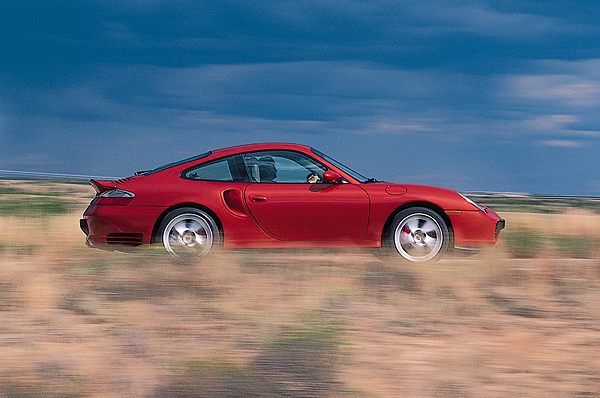
With a 415-horsepower (309 kW) twin-turbo engine, advanced all-wheel drive, and exclusive styling, the new Porsche® 911 Turbo takes its place at the top of the Porsche model line and in the top echelon of the supercar category. The 911 Turbo stands apart from the 911 Carrera® and 911 Carrera 4 models with all new front and rear styling, as well as a wider stance. Unique bi-xenon headlight clusters feature xenon high-intensity discharge headlights for both the low and high beams. The upper part of an all-new two-piece rear stabilizer wing automatically raises at speeds above 75 mph (120 kph) and lowers at speeds below 50 mph (80 km/h). Derived from the Porsche GT1 racecar, the 3.6-liter, horizontally opposed six-cylinder engine sustains 415 lb.-ft. (560 Nm) of peak torque from 2,700 rpm to 4,600 rpm. In place of a conventional throttle cable setup, the E-Gas electronic throttle transmits pedal position to the engine control unit. Power drives through a standard six-speed manual transmission, and, for the first time in a 911 Turbo, Porsche offers the Tiptronic S five-speed automatic transmission as an option. The 911 Turbo can accelerate from 0-62 mph (0-100 kph) in just 4.2 seconds. On the test track, the 911 Turbo can sprint from a standstill to 100 mph (160 kph) in only 9.2 seconds and achieve a top track speed of 189 mph (305 km/h). The standard aluminum alloy wheels measure 18 x 8 inches in front and mount 225/40 ZR18 tires; the 18 x 11-inch rear wheels mount 295/30 ZR18 tires. Also derived from the GT1 racecar, one-piece, four-piston brake calipers reduce unsprung weight and heat and feature 13-inch vented, cross-drilled discs front and rear. The Porsche Ceramic Composite Brake (PCCB)®, available as an option (late availability), will set new standards for brake response, fade resistance and service life. The standard Porsche Stability Management system (PSM) can detect a loss of grip at the front or rear and reduce instability by applying braking to individual wheels and, if necessary, altering engine power.
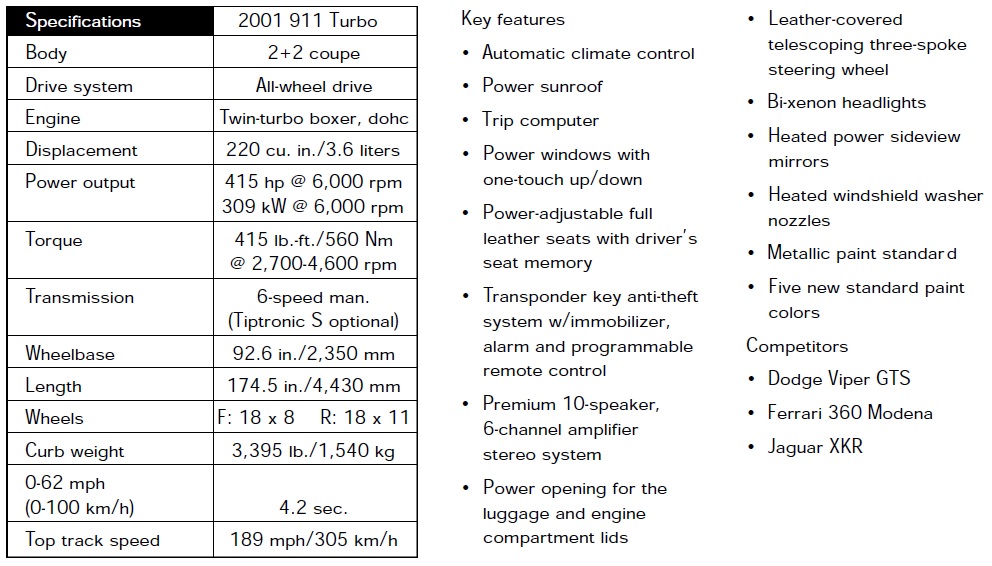
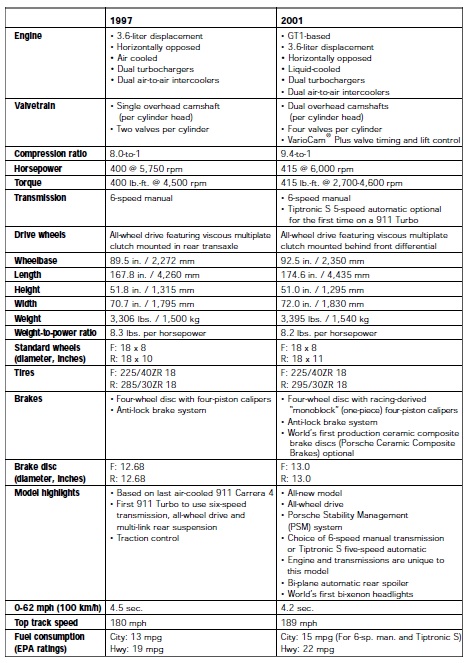
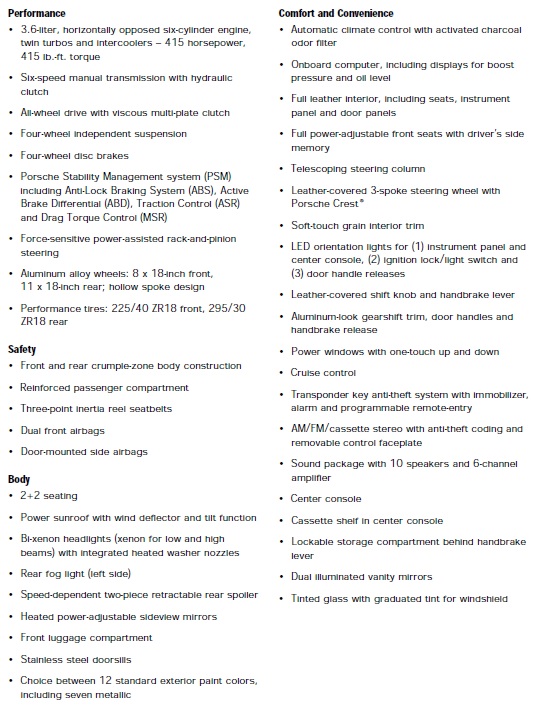
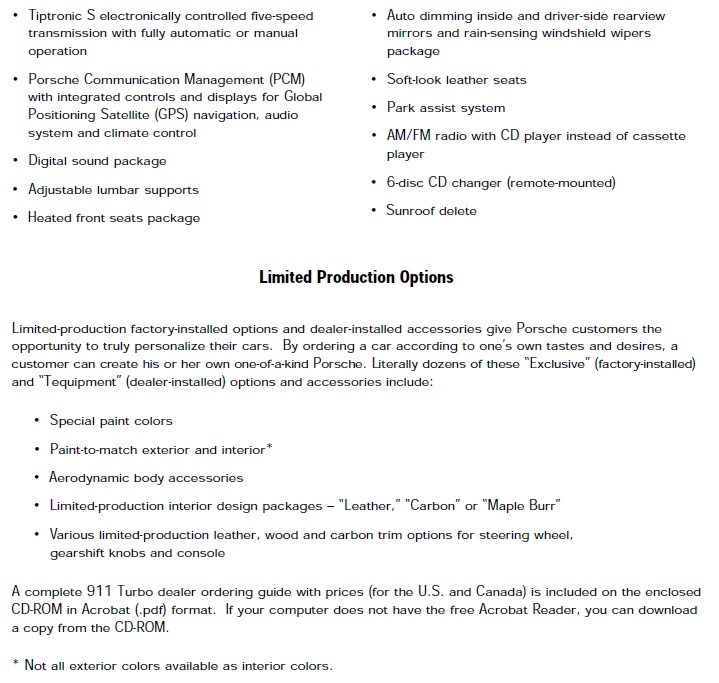
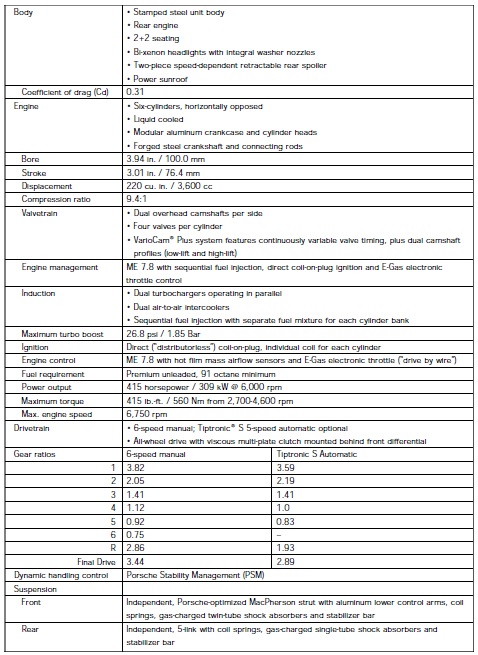
.jpg)
2000 Porsche 911 Turbo
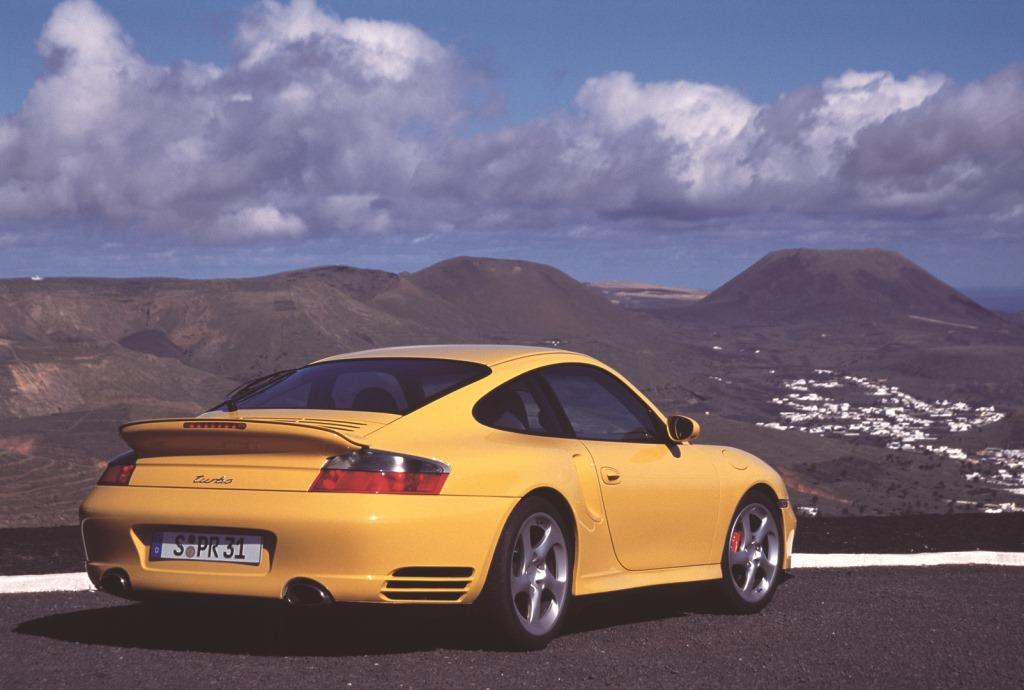
2002 Porsche 911 Turbo

Porsche Press kit

Porsche Literature

Our Porsche Cars